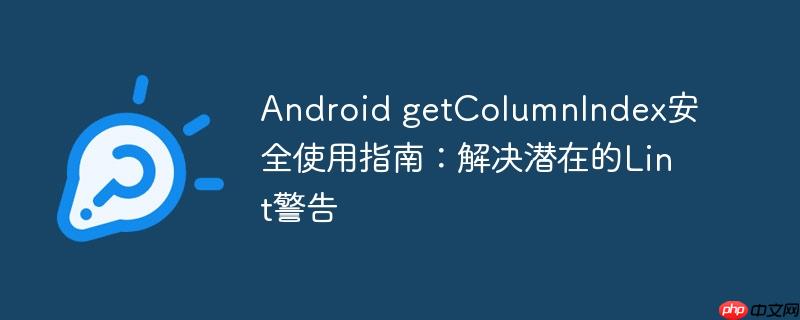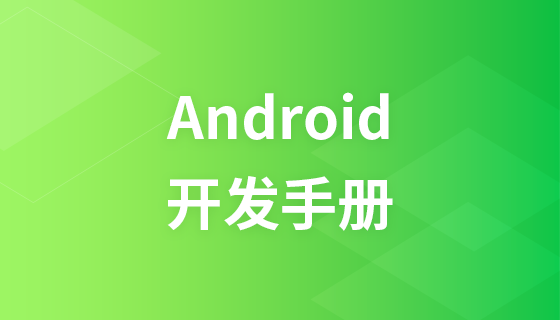
在Android开发中,当我们需要从Cursor对象中获取特定列的数据时,通常会使用getColumnIndex()方法来获取该列的索引。然而,getColumnIndex()方法有一个重要的特性:如果指定的列名在Cursor中不存在,它将返回-1。随后的getString()、getInt()等方法在接收到-1作为索引时,会抛出ArrayIndexOutOfBoundsException或导致其他运行时错误。Android Lint工具为了帮助开发者避免这类潜在问题,会发出“Value must be ≥ 0 but getColumnIndex can be -1”的警告。
考虑以下常见的代码片段,它在尝试获取联系人ID和电话号码时可能会触发此警告:
private ArrayList<String> getAllPhoneContacts(){
ArrayList<String> phoneList = new ArrayList<>();
ContentResolver contentResolver = getContentResolver();
Cursor cursor = contentResolver.query(ContactsContract.Contacts.CONTENT_URI, null, null, null, null);
if ((cursor !=null ? cursor.getCount() : 0) > 0){
while(cursor.moveToNext()){
// 潜在的警告点:getColumnIndex(ContactsContract.Contacts._ID)
String id = cursor.getString(cursor.getColumnIndex(ContactsContract.Contacts._ID));
// 潜在的警告点:getColumnIndex(ContactsContract.Contacts.HAS_PHONE_NUMBER)
if (cursor.getInt(cursor.getColumnIndex(ContactsContract.Contacts.HAS_PHONE_NUMBER)) > 0){
Cursor phoneCursor = contentResolver.query(
ContactsContract.CommonDataKinds.Phone.CONTENT_URI,
null,
ContactsContract.CommonDataKinds.Phone.CONTACT_ID + " = ?",
new String[]{id},null);
while(phoneCursor.moveToNext()){
// 潜在的警告点:getColumnIndex(ContactsContract.CommonDataKinds.Phone.NUMBER)
String phoneNo = phoneCursor.getString(phoneCursor.getColumnIndex(ContactsContract.CommonDataKinds.Phone.NUMBER));
phoneList.add(phoneNo);
}
phoneCursor.close();
}
}
}
if (cursor !=null){
cursor.close();
}
return phoneList;
}接下来,我们将探讨三种有效解决此Lint警告并提升代码健壮性的方法。
最直接但通常不推荐作为长期解决方案的方法是使用@SuppressLint("Range")注解来抑制Lint警告。这告诉Lint工具在特定代码块或方法中忽略“值范围”相关的检查。
使用场景: 当你非常确定某个列始终存在,或者你已经通过其他方式确保了其存在性,并且希望快速消除警告时。
优点:
缺点:
示例代码:
import android.annotation.SuppressLint;
// ... 其他导入
public class MyContactsActivity extends AppCompatActivity {
// ... 其他代码
@SuppressLint("Range") // 抑制此方法内的所有"Range"警告
private ArrayList<String> getAllPhoneContacts(){
ArrayList<String> phoneList = new ArrayList<>();
ContentResolver contentResolver = getContentResolver();
Cursor cursor = contentResolver.query(ContactsContract.Contacts.CONTENT_URI, null, null, null, null);
if ((cursor !=null ? cursor.getCount() : 0) > 0){
while(cursor.moveToNext()){
String id = cursor.getString(cursor.getColumnIndex(ContactsContract.Contacts._ID));
if (cursor.getInt(cursor.getColumnIndex(ContactsContract.Contacts.HAS_PHONE_NUMBER)) > 0){
Cursor phoneCursor = contentResolver.query(
ContactsContract.CommonDataKinds.Phone.CONTENT_URI,
null,
ContactsContract.CommonDataKinds.Phone.CONTACT_ID + " = ?",
new String[]{id},null);
while(phoneCursor.moveToNext()){
String phoneNo = phoneCursor.getString(phoneCursor.getColumnIndex(ContactsContract.CommonDataKinds.Phone.NUMBER));
phoneList.add(phoneNo);
}
phoneCursor.close();
}
}
}
if (cursor !=null){
cursor.close();
}
return phoneList;
}
}Cursor接口提供了getColumnIndexOrThrow()方法,它与getColumnIndex()行为类似,但如果指定的列名不存在,它会抛出IllegalArgumentException而不是返回-1。这使得问题在运行时能够被及时捕获,而不是默默地导致后续的崩溃。
使用场景: 当你认为某个列是必需的,如果它不存在,则应该视为程序逻辑错误并立即终止操作时。
优点:
缺点:
示例代码:
import android.util.Log;
// ... 其他导入
private ArrayList<String> getAllPhoneContacts(){
ArrayList<String> phoneList = new ArrayList<>();
ContentResolver contentResolver = getContentResolver();
Cursor cursor = contentResolver.query(ContactsContract.Contacts.CONTENT_URI, null, null, null, null);
if ((cursor !=null ? cursor.getCount() : 0) > 0){
while(cursor.moveToNext()){
try {
// 使用 getColumnIndexOrThrow()
String id = cursor.getString(cursor.getColumnIndexOrThrow(ContactsContract.Contacts._ID));
// 使用 getColumnIndexOrThrow()
int hasPhoneNumberIndex = cursor.getColumnIndexOrThrow(ContactsContract.Contacts.HAS_PHONE_NUMBER);
if (cursor.getInt(hasPhoneNumberIndex) > 0){
Cursor phoneCursor = contentResolver.query(
ContactsContract.CommonDataKinds.Phone.CONTENT_URI,
null,
ContactsContract.CommonDataKinds.Phone.CONTACT_ID + " = ?",
new String[]{id},null);
while(phoneCursor.moveToNext()){
// 使用 getColumnIndexOrThrow()
String phoneNo = phoneCursor.getString(phoneCursor.getColumnIndexOrThrow(ContactsContract.CommonDataKinds.Phone.NUMBER));
phoneList.add(phoneNo);
}
phoneCursor.close();
}
} catch (IllegalArgumentException e) {
// 捕获列不存在的异常,可以记录日志或进行其他处理
Log.e("Contacts", "列不存在或访问错误: " + e.getMessage());
// 根据业务逻辑,可以选择跳过当前联系人或整个操作
continue;
}
}
}
if (cursor !=null){
cursor.close();
}
return phoneList;
}这是最推荐的方法,它结合了getColumnIndex()的灵活性和显式检查的安全性。我们先调用getColumnIndex()获取索引,然后在使用这个索引之前,检查它是否大于或等于0。如果索引为-1,则表示列不存在,我们可以根据业务逻辑进行处理(例如,提供默认值、跳过数据或记录日志)。
使用场景: 当你预期某些列可能存在或不存在,并且希望以健壮的方式处理这两种情况时。
优点:
缺点:
示例代码:
import android.util.Log;
// ... 其他导入
private ArrayList<String> getAllPhoneContacts(){
ArrayList<String> phoneList = new ArrayList<>();
ContentResolver contentResolver = getContentResolver();
Cursor cursor = contentResolver.query(ContactsContract.Contacts.CONTENT_URI, null, null, null, null);
if ((cursor !=null ? cursor.getCount() : 0) > 0){
// 在循环外获取常用列的索引,提高效率
int idColumnIndex = cursor.getColumnIndex(ContactsContract.Contacts._ID);
int hasPhoneNumberColumnIndex = cursor.getColumnIndex(ContactsContract.Contacts.HAS_PHONE_NUMBER);
while(cursor.moveToNext()){
String id = null;
if (idColumnIndex >= 0) { // 检查索引是否有效
id = cursor.getString(idColumnIndex);
} else {
Log.w("Contacts", "联系人ID列不存在,跳过当前联系人。");
continue; // ID是必需的,如果不存在则跳过
}
if (hasPhoneNumberColumnIndex >= 0) { // 检查索引是否有效
if (cursor.getInt(hasPhoneNumberColumnIndex) > 0){
Cursor phoneCursor = contentResolver.query(
ContactsContract.CommonDataKinds.Phone.CONTENT_URI,
null,
ContactsContract.CommonDataKinds.Phone.CONTACT_ID + " = ?",
new String[]{id},null);
if (phoneCursor != null) {
int phoneNumberColumnIndex = phoneCursor.getColumnIndex(ContactsContract.CommonDataKinds.Phone.NUMBER);
while(phoneCursor.moveToNext()){
if (phoneNumberColumnIndex >= 0) { // 检查索引是否有效
String phoneNo = phoneCursor.getString(phoneNumberColumnIndex);
phoneList.add(phoneNo);
} else {
Log.w("Contacts", "电话号码列不存在,跳过当前电话号码。");
}
}
phoneCursor.close();
}
}
} else {
Log.i("Contacts", "HAS_PHONE_NUMBER列不存在,假定无电话号码。");
// 可以选择在这里处理无电话号码的情况
}
}
}
if (cursor !=null){
cursor.close();
}
return phoneList;
}注意事项:
选择哪种解决方案取决于你的具体需求和对数据完整性的预期:
额外提示:
通过采纳上述的解决方案和最佳实践,你将能够有效解决getColumnIndex相关的Lint警告,并显著提升Android数据访问代码的健壮性和可靠性。
以上就是Android getColumnIndex安全使用指南:解决潜在的Lint警告的详细内容,更多请关注php中文网其它相关文章!

每个人都需要一台速度更快、更稳定的 PC。随着时间的推移,垃圾文件、旧注册表数据和不必要的后台进程会占用资源并降低性能。幸运的是,许多工具可以让 Windows 保持平稳运行。




Copyright 2014-2025 https://www.php.cn/ All Rights Reserved | php.cn | 湘ICP备2023035733号